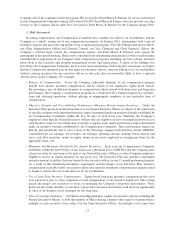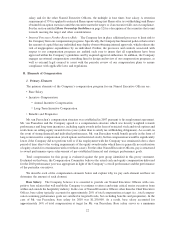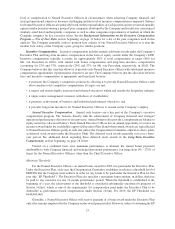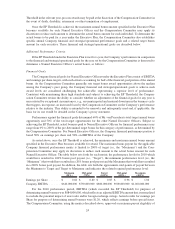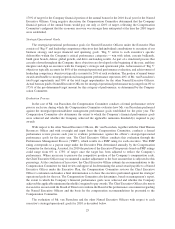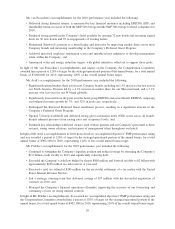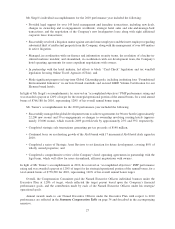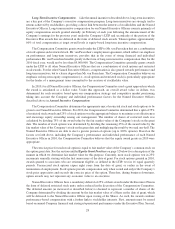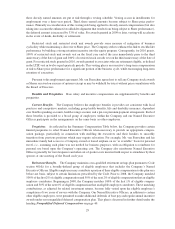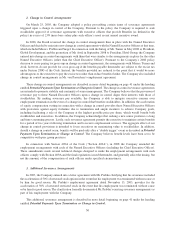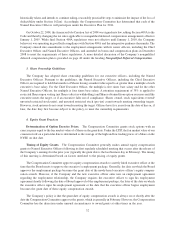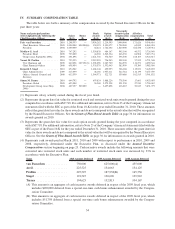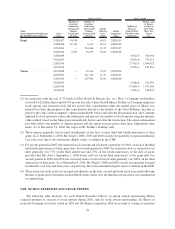Starwood 2010 Annual Report Download - page 41
Download and view the complete annual report
Please find page 41 of the 2010 Starwood annual report below. You can navigate through the pages in the report by either clicking on the pages listed below, or by using the keyword search tool below to find specific information within the annual report.these already earned amounts are put at risk through a vesting schedule. Vesting occurs in installments for
employment over a three-year period. Third, these earned amounts become subject to Share price perfor-
mance. Primarily in consideration of this vesting risk being applied to already earned compensation (but also
taking into account the enhanced stockholder alignment that results from being subject to Share performance),
the deferred amount is increased by 33% of value. For awards granted in 2009 or later, vesting will accelerate
in the event of death, disability or retirement.
Restricted stock and restricted stock unit awards provide some measure of mitigation of business
cyclicality while maintaining a direct tie to Share price. The Company seeks to enhance the link to stockholder
performance by building a strong retention incentive into the equity program. Consequently, for 2010 grants,
100% of restricted stock unit awards vest on the fiscal year end of the year immediately prior to the third
anniversary of the date of grant and 100% of restricted stock awards vest on the third anniversary of the date of
grant. For restricted stock granted in 2010, awards granted to associates who are retirement eligible, as defined
in the LTIP, vest in twelve equal quarterly periods. This vesting places an executive’s long-term compensation
at risk to Share price performance for a significant portion of the business cycle, while encouraging long-term
retention of executives.
Pursuant to his employment agreement, Mr. van Paasschen agreed not to sell any Company stock awards
or Shares received on exercise of options (except as may be withheld for taxes) without prior consultation with
the Board of Directors.
Benefits and Perquisites. Base salary and incentive compensation are supplemented by benefits and
perquisites.
Current Benefits. The Company believes the employee benefits it provides are consistent with local
practices and competitive markets, including group health benefits, life and disability insurance, dependent
care flexible spending accounts, health savings account, and a pre-tax premium payment arrangement. Each of
these benefits is provided to a broad group of employees within the Company and our Named Executive
Officers participate in the arrangements on the same basis as other employees.
Perquisites. As reflected in the Summary Compensation Table below, the Company provides certain
limited perquisites to select Named Executive Officers when necessary to provide an appropriate compen-
sation package, particularly in connection with enabling the executives and their families to smoothly
transition from previous positions which may require relocation. For example, Mr. van Paasschen and his
immediate family had access to a Company owned or leased airplane on an “as available” basis for personal
travel, i.e., assuming such plane was not needed for business purposes, with an obligation to reimburse for
personal use based upon the Company’s operating cost. The Company also reimburses Named Executive
Officers generally for travel expenses and other out-of-pocket costs incurred with respect to attendance by their
spouses at one meeting of the Board each year.
Retirement Benefits. The Company maintains a tax-qualified retirement savings plan pursuant to Code
section 401(k) for a broadly-defined group of eligible employees that includes the Company’s Named
Executive Officers. Eligible employees may contribute a portion of their eligible compensation to the plan on a
before-tax basis, subject to certain limitations prescribed by the Code. Prior to 2008, the Company matched
100% of the first 2% of eligible compensation and 50% of the next 2% of eligible compensation that an eligible
employee contributes. Beginning in 2008, the Company matches 100% of the first 1% of eligible compen-
sation and 50% of the next 6% of eligible compensation that an eligible employee contributes. These matching
contributions, as adjusted for related investment returns, become fully vested upon the eligible employee’s
completion of two years of service with the Company. Our Named Executive Officers, in addition to certain
other eligible employees, were permitted to make additional deferrals of base pay and regular annual incentive
awards under our nonqualified deferred compensation plan. This plan is discussed in further detail under the
heading Nonqualified Deferred Compensation on page 40.
29




